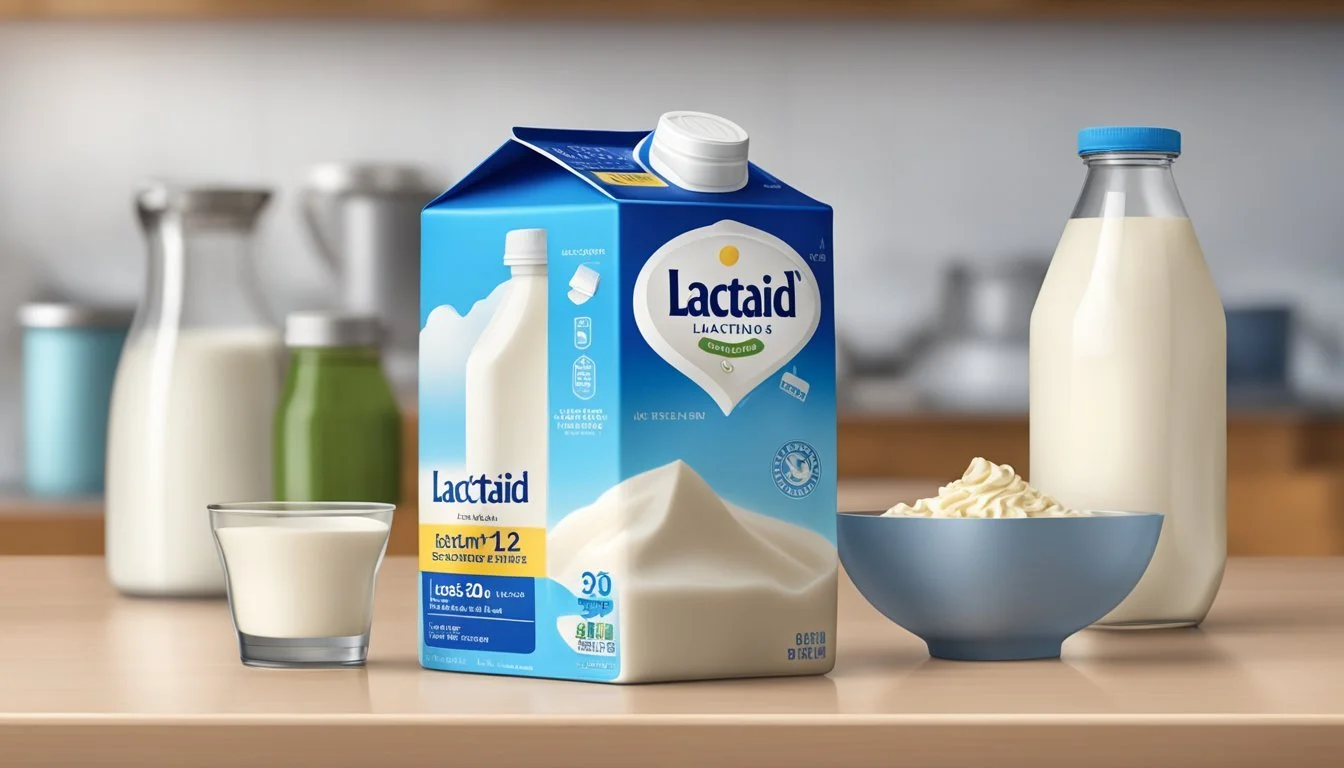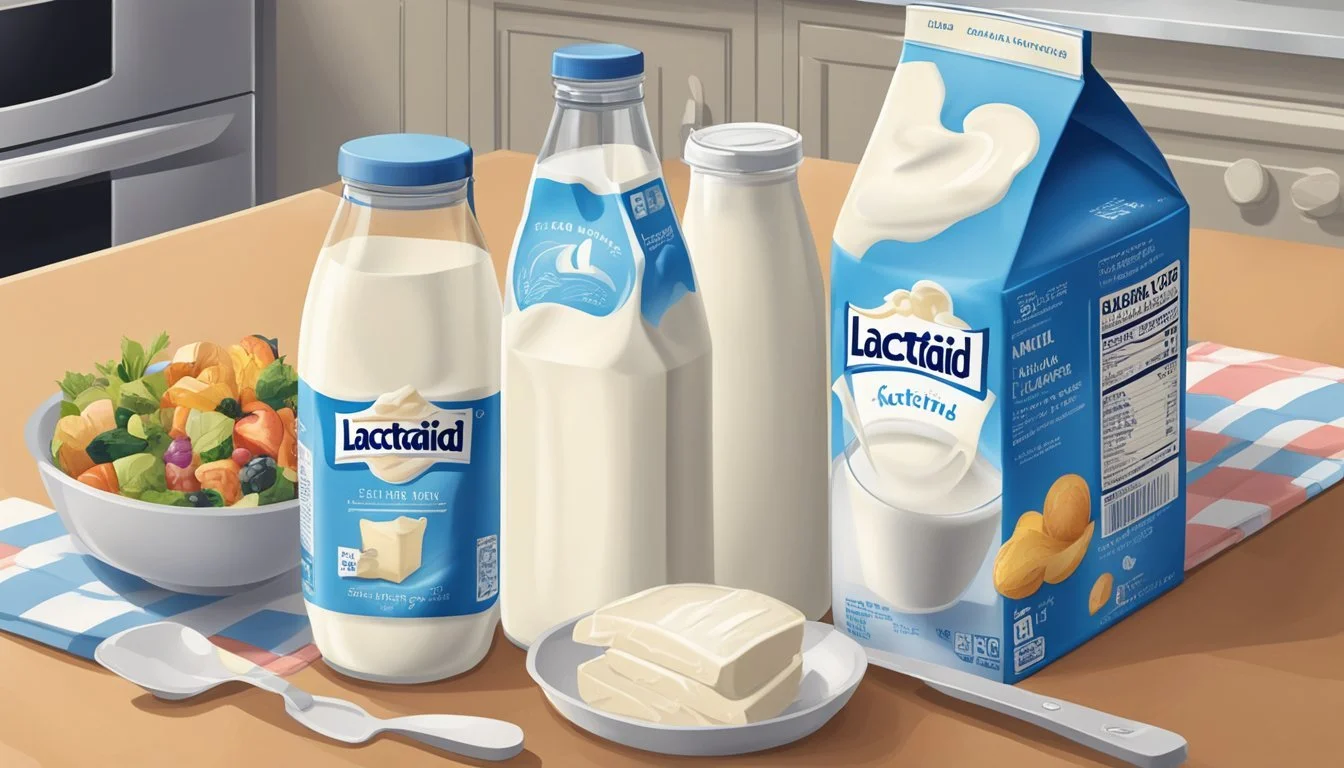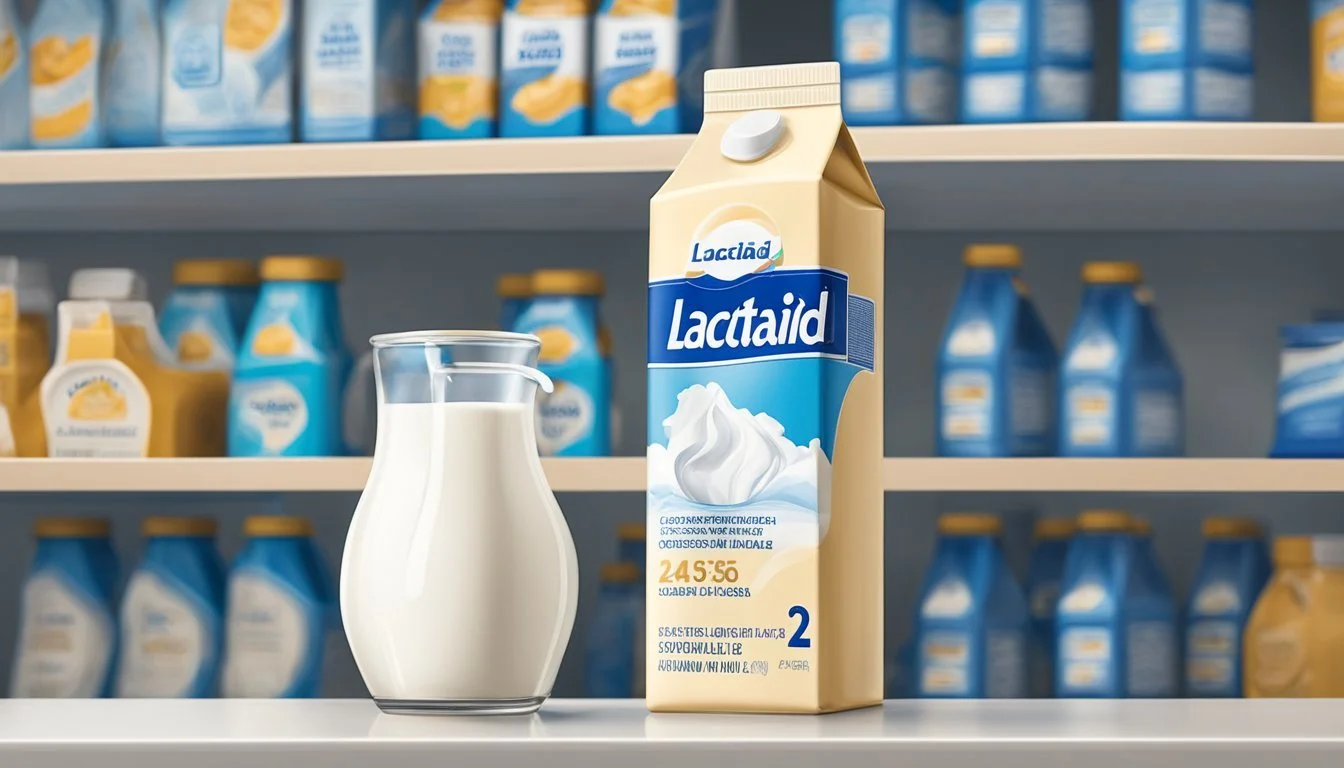How Long Does Lactaid Lactose-Free Milk Last After Opening?
Shelf Life Explained
Lactose-free milk, such as Lactaid, is a dairy product specially processed to remove lactose, a sugar found in milk and dairy products that can cause discomfort for individuals with lactose intolerance. Lactose-free milk offers an alternative to traditional milk, allowing those with intolerance to enjoy the taste and nutritional benefits of milk without experiencing adverse reactions.
Lactaid milk typically has a similar shelf life to regular cow's milk, meaning it can stay fresh for the same duration when handled properly. It is important that lactose-free milk is stored in a refrigerator at or below 40° F to maintain its freshness. An unopened carton of lactose-free milk generally remains fresh until the stamped "sell-by" date, and even once opened, it can last for about 5-7 days, ensuring continuous refrigeration.
Consuming dairy products is a common dietary practice, and for people with lactose intolerance, lactose-free milk is 100% real milk that provides essential nutrients without causing discomfort that lactose may trigger. Maintaining proper storage and paying attention to the shelf-life details ensures that lactose-free milk remains a safe and enjoyable option for those looking to include dairy in their diet without the lactose.
Understanding Lactose-Free Milk
Lactose-free milk caters to those with lactose intolerance by providing a dairy option that negates the discomfort associated with lactose digestion, while still offering comparable nutritional benefits to regular milk.
Production Process
Lactose-free milk is produced by adding the enzyme lactase to regular milk, which breaks down lactose, a complex sugar, into two simpler sugars: glucose and galactose. This process pre-digests the lactose, allowing consumers who are lactose intolerant to enjoy dairy products without experiencing gastrointestinal discomfort.
Health Benefits for Lactose Intolerants
For individuals with lactose intolerance, lactose-free milk provides significant health benefits. It enables them to consume milk without adverse symptoms such as bloating or cramps. Importantly, it is not suitable for individuals with a dairy allergy, as it contains other dairy components that can still trigger allergic reactions.
Nutritional Comparison with Regular Milk
When comparing lactose-free milk to regular milk, the primary nutritional difference is in the sugar content. Although the total sugar content remains the same, lactose-free milk contains glucose and galactose instead of lactose. The overall protein, vitamin, and mineral content are largely equivalent to that of regular milk.
Shelf Life Essentials
When considering the shelf life of Lactaid lactose-free milk, it's important to understand the role of expiration and sell-by dates, the impact of pasteurization techniques, and the signs of spoilage.
Expiration and Sell-By Dates
Lactose-free milk's longevity is closely tied to its expiration and sell-by dates, which reflect the manufacturer's estimate of how long the product will maintain its quality. Typically, lactose-free milk remains safe to consume for about one week past the sell-by date when properly refrigerated.
Impact of Pasteurization Techniques
The shelf life of lactose-free milk is also affected by pasteurization techniques. Most Lactaid milk undergoes either high-temperature short-time (HTST) pasteurization or ultra high temperature (UHT) pasteurization. UHT pasteurized milk, which is heated to higher temperatures, often has a longer shelf life than HTST-pasteurized milk due to reduced microbial content.
Signs of Spoilage
To assess if Lactaid milk has spoiled, one should look for:
Changes in color or texture
Off-putting odors
Any signs of mold
It is important to discard the milk if any of these signs are present, regardless of the printed dates. Storage conditions are critical; maintaining a consistent refrigerator temperature at or below 40° F ensures optimal shelf life.
Proper Storage of Lactose-Free Milk
Ensuring lactose-free milk retains its freshness relies heavily on how it is stored. This section outlines the procedures for extending the shelf life of lactose-free milk from the moment of purchase through its usage.
Storing Unopened Lactose-Free Milk
Unopened lactose-free milk should always be kept refrigerated. The ideal temperature for storage is at or below 40° F. One should avoid placing milk on the fridge door, as temperatures there tend to fluctuate, which can affect the milk's integrity. If the milk is ultra-pasteurized (UP), it has a longer shelf life due to the ultra high temperature treatment that eliminates most bacteria.
Place unopened lactose-free milk:
In the main body of the fridge.
Away from the door to prevent exposure to variable temperatures.
Handling After Opening
Once opened, the milk gets exposed to airborne microorganisms, which can hasten spoilage. To maintain quality, lactose-free milk should be consumed within 7 days of opening, provided it remains refrigerated and the original "sell by" date has not passed. Transferring the milk to an airtight container can also help minimize exposure to air and other contaminants.
Tips post-opening:
Keep refrigerated.
Transfer to an airtight container, if possible.
Consume within 5-7 days.
Freezing Lactose-Free Milk
Freezing lactose-free milk is an option for extending its shelf life, though it may result in slight changes in texture and taste. To freeze, ensure the milk is in an airtight container with enough space to expand. It can be frozen for up to three months. Thaw the milk in the refrigerator, and shake well before using to redistribute the fats and proteins that may have separated.
How to freeze and thaw:
Leave space in the container for expansion.
Freeze for up to 3 months.
Thaw in the refrigerator and shake well before use.
Safety and Consumption
When considering the safety and consumption of Lactaid lactose-free milk, it is crucial for consumers to recognize the signs of milk that remains safe for consumption, choose reputable brands, and understand the symptoms associated with dairy consumption issues for those with lactose intolerance.
Recognizing Safe Lactose-Free Milk
Safe lactose-free milk should be consistently refrigerated at or below 40° F to inhibit the growth of bacteria. Upon opening, it usually lasts for about 5-7 days, but this can vary depending on the pasteurization process. Consumers should inspect the milk visually for any changes in color or texture, and smell the milk before use to detect any sour odors, both of which can indicate spoilage.
Selecting Quality Brands
Choosing a quality brand of lactose-free milk often involves looking for milk that has undergone ultra-pasteurization, a process that extends its shelf life. Shoppers should opt for brands that explicitly state they have been pasteurized and check for a "sell-by" date. It's advisable to select lactose-free milk from a refrigerated section in grocery stores, as these brands adhere to strict quality control measures to ensure the product's integrity.
Symptoms of Dairy Consumption Issues
While Lactaid lactose-free milk is designed to minimize symptoms such as cramps, bloating, or discomfort typically associated with lactose intolerance, individual reactions may vary. Not all dairy sensitivity is due to lactose; some individuals may react to the protein in milk. Consumers should pay attention to their body's responses and consult with a healthcare provider if they experience persistent symptoms after consuming lactose-free milk products.
Using Lactose-Free Milk in Cooking
Lactose-free products, including milk, offer those with lactose intolerance the opportunity to enjoy dairy without discomfort. When it comes to cooking, they can effortlessly replace regular milk to create wholesome, lactose-free versions of favorite recipes.
Adapting Recipes for Lactose-Free Milk
When cooking with lactose-free milk, one should consider its slight sweetness, due to the breaking down of lactose into simpler sugars. For savory dishes, this may require adjusting spices or seasonings to balance flavors. In baking, lactose-free milk can be used just as conventional milk. If a recipe calls for buttermilk, add one tablespoon of vinegar or lemon juice to one cup of lactose-free milk and allow it to sit for five minutes before use.
Baking: Direct substitute, with acidity adjustment for buttermilk.
Savory dishes: Minor seasoning adjustments may be necessary.
Choosing Lactose-Free Products for Cooking
Not all lactose-free products behave identically in recipes. When selecting a product, read labels to match fat content to the recipe's needs — for instance, choose whole lactose-free milk for creamier textures. Lactose-free yogurt can also be used in recipes, functioning similarly to its conventional counterpart. Always ensure the lactose-free product is fresh to maintain the integrity of the dish.
Here's a simple table to help with selection:
Product Type Use Case Consideration Lactose-Free Milk General cooking, baking Check fat content for desired result Lactose-Free Yogurt Desserts, sauces, marinades Ensure freshness; choose plain varieties for savory dishes
Considerations for Different Age Groups
When incorporating lactose-free milk into diets, it's critical to understand how long it can remain usable after opening and the specific considerations for different age groups, such as children and adults who are lactose intolerant.
Lactose-Free Milk for Children
For children who are lactose intolerant, lactose-free milk is a beneficial alternative as it allows them to enjoy dairy without the discomfort of diarrhea, bloating, or gas which are common symptoms of lactose intolerance. However, the freshness of the milk is vital. Once opened, lactose-free milk typically remains fresh for 5-7 days if stored properly in the refrigerator. It is important to check the "sell by" date and observe the milk for any signs of spoilage before giving it to children, as they are more susceptible to foodborne illnesses.
Advice for Lactose-Intolerant Adults
Adults with lactose intolerance typically experience discomfort after consuming dairy products due to the body's inability to break down lactose. Like with children, lactose-free milk provides adults the opportunity to enjoy milk products. However, adults should also adhere to the 5-7 day guideline for an opened carton of lactose-free milk stored in the refrigerator. Consuming lactose-free milk past this period can lead to spoilage and may result in foodborne illnesses, which are particularly concerning for adults with weakened immune systems.
Understanding Lactose Intolerance and Related Disorders
Lactose intolerance is a common digestive issue resulting from the body's inability to digest lactose, a sugar found in milk and dairy products. It is important to distinguish this condition from a milk allergy and understand alternative calcium sources for a balanced diet.
Symptoms and Diagnosis of Lactose Intolerance
Symptoms of lactose intolerance typically occur within hours after consuming dairy products and include abdominal pain, bloating, gas, diarrhea, and in some cases, nausea and vomiting. Diagnosis is often achieved through a medical history review and may involve a Hydrogen Breath Test, which measures hydrogen levels in the breath after lactose consumption, indicating if lactose has been improperly digested in the small intestine.
Abdominal Pain: A common symptom, occurring due to gas and bloating.
Diarrhea: Results from undigested lactose entering the large intestine.
Differentiating Milk Allergy and Lactose Intolerance
Lactose intolerance should not be confused with a milk allergy, which is an immune reaction to the proteins in milk rather than an enzyme deficiency. While lactose intolerance involves digestive issues, a milk allergy can cause more severe reactions like hives, swelling, and in extreme cases, anaphylaxis.
Milk Allergy Symptoms: Can include skin reactions, respiratory problems, and anaphylaxis.
Lactose Intolerance Symptoms: Mainly digestive, such as gas and bloating.
Nutritional Considerations and Calcium Sources
Individuals who are lactose intolerant need to consider alternative calcium sources to maintain bone health. While dairy is a well-known calcium provider, there are other calcium-rich foods that do not contain lactose or can be consumed in lactose-free forms.
Calcium-Rich Foods: Include leafy greens, almonds, and fortified non-dairy milks.
Supplements: Calcium supplements can be an option, preferably taken as advised by a healthcare provider.
Regulatory Standards and Food Safety
Regulatory oversight and correct packaging practices are essential for maintaining the safety and shelf life of lactose-free milk products such as Lactaid. They help ensure that the products consumers enjoy are safe, of high quality, and properly labeled.
FDA Regulations on Milk Products
The Food and Drug Administration (FDA) sets forth regulations to oversee the safety and labeling of milk products, including lactose-free options. Milk is often pasteurized to eliminate pathogens, with standards dictating the minimum time and temperature required for this process. Ultra-Pasteurized (UP) and Ultra High Temperature (UHT) processing methods further extend the shelf life by heating the milk to higher temperatures, significantly reducing the microbial load.
Importance of Packaging and Labeling
Effective packaging is key to preserving the quality and extending the shelf life of lactose-free milk. Properly sealed containers prevent the entry of microorganisms and protect the milk from spoilage. Accurate labeling, mandated by the FDA, informs consumers of critical information such as sell-by or use-by dates, helping them determine the freshness and safety of the product. The shelf life of an open carton of lactose-free milk, when stored in a refrigerator, generally lasts about 5-7 days post the opening when maintained under appropriate conditions.








